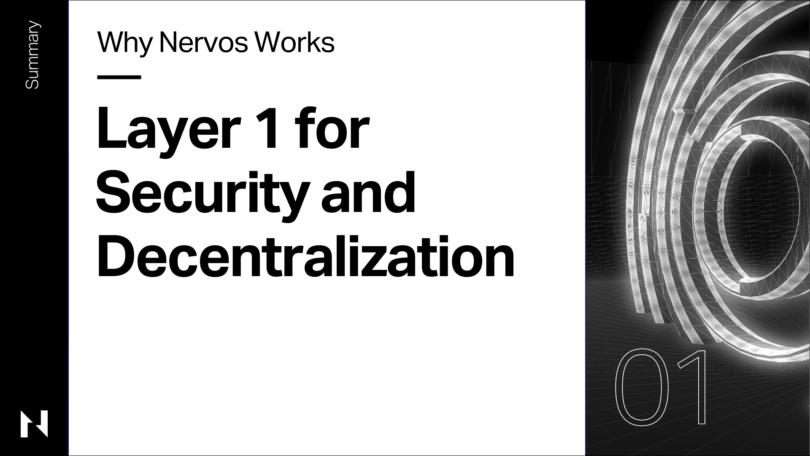Since Nervos was founded in 2018, we have been working to create a blockchain platform that has the capabilities to forge a new path in Web 3.0. This means not only being a successful and viable platform today, but also having the foundations to be future-proof in a fast-paced space.
The construction of Nervos is what makes it a platform with such potential. A solid and secure Layer 1, with a Layer 2 environment that is flexible and scalable, is aimed at being inherently multi-chain.
To better understand Nervos’ goals, it is good to get a grasp of its foundational layer – The Common Knowledge Base (CKB). CKB, while also the token ticker, is Nervos’ Layer 1 and provides, among other things, the highest degree of blockchain security and potential for decentralization.
More than this, the construction of CKB allows for a flexible and scalable Layer 2 to work independently and independently on top of it, making it an ideal playground for blockchain dApp developers.
In this article, we will be diving into Why Nervos Works: Layer 1
Store of Assets
At its core, CKB is a Store of Assets public permissionless blockchain; the same description can also be given to Bitcoin. However, CKB is different from Bitcoin, but does borrow a lot of its good bits.
First of all, CKB, like Bitcoin, is Proof-of-Work, and while there has been a lot of debate around the environmental impact of PoW coins, much of the arguments are straw man fallacies. PoW was selected for Nervos’ Layer 1 because only PoW meets all the demands for a truly decentralized system.
Proof-of-Stake systems permission the consensus process, allowing the largest validators to consolidate their status over time and entrench themselves in positions of power on the network. PoW, on the other hand, offers far more open access to competition, and no one is likely to maintain a leading edge in technology and operation forever.
A Layered Approach
PoW helps with decentralization, but also with security, this is because CKB is purposefully tasked with security for the network. This layer doesn’t do any computation, but focuses solely on validation of transactions, keeping the blockchain honest.
CKB is referred to as being a “cryptographic court” because it serves as a regulator for off-chain transactions. This frees up Layer 2 to focus on scalability while providing optimal decentralization.
This layered architecture of Nervos, as highlighted above, shows how the two layers work independently and independently of each other. It also shows how we have settled issues of scalability and fluidity while maintaining security and decentralization due to the make up of CKB.
This layered approach means Nervos has the ability to store assets, like Bitcoin, but it also has smart contract capabilities, like Ethereum. However, CKB has been designed to be a state verification and storage system instead of a computation platform. The Layer 1 blockchain verifies and stores states, while the computation-intensive state generation happens on Layer 2.
The Common Knowledge Base
The name for our Layer 1 is not arbitrarily chosen. Common knowledge is information that is accepted by a group of people, but not only does this group have common knowledge, they also know that other participants in the group have the same knowledge – and this is important for Nervos and Blockchain.
The idea of Bitcoin was to create a public accounting ledger that records who owns what, and keeps track of all transactions. Money is the common knowledge stored in the Bitcoin ledger.
At Nervos, we want to take this one step further and store more kinds of common knowledge (e.g. digital assets, smart contracts, crypto proofs for arbitration, identities, etc.) on the Nervos CKB. This is different to current blockchains which are fundamentally fixed, once they are built.
While they will be upgraded over time, their structure will generally remain the same. To see the challenge this brings, we can look at how difficult it has been to bring Segwit to Bitcoin or Wasm to Ethereum.
CKB takes a step back. Scripts are far more primitive than smart contracts in Ethereum, but carry a significant benefit: flexibility. Almost all algorithms and data structures are implemented in CKB scripts stored within cells.
On CKB, if you are not satisfied with fundamental functionality, such as a signature algorithm or hash function, just roll up your sleeves and build what you need.
CKB is like an organic construction, rather than a work of traditional engineering. It allows the network to evolve at its lowest level, and for there to be continual adaptation and adjustment from the ground up.
This is the first in a four-part series that breaks down the architecture of Nervos and why it works as a blockchain platform for today, and into the future, Stay tuned for part 2: Why Nervos Works: Layer 2 for Flexibility and Future Proofing
To stay updated on all things Nervos:
Join our community: Discord — Github — Nervos Talk Forum — Twitter
For discussions or questions join the conversation on Discord or check out one of our community Telegram channels: English, Korean, Russian, Japanese, Spanish, Vietnamese and Chinese
